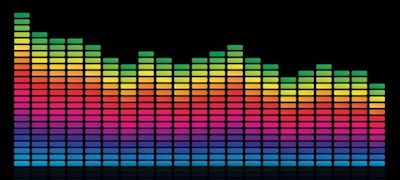
How to Be a Better Dance DJ
Guidelines for playing recorded music at a social dance party
Richard Powers

A) Your tunes come in a range of tempos, B) Some of your tunes have a driving highTake a rotating (Viennese or rotary) waltz for example. The sweet spot for intermediate dancers is around 144 bpm. A common DJ mistake is to play a quiet ballad or gentle waltz that happens to be a fast tempo, say 160 or 170 bpm. A good example is "You've Got to Hide Your Love Away" by the Beatles. To the dancers (especially the Leads) waltzing now feels like hard work — more effort is required at that fast tempo than the gentle music is providing. But a powerful driving rhythmic tune at the same 170 tempo would be fine.
above and below the sweet-spot tempo for energy, and some have an easygoing low energy.
each dance form.
A and B must correspond. Tunes with tempos above the sweet spot must have correspondingly higher energy, to support the extra effort required to dance faster, and vice versa for tunes below the sweet spot tempo. This is a straightforward calculation. (1) Get a metronome (click for an online metronone) or beat-checking software and find the tempo. (2) Look at the sweet spot chart at the bottom of this page. If the tempo is significantly above the sweet spot tempo, but it's one of the quieter, gentler tunes you have for that dance form, then don't play it.
DANCE TYPE SWEET SPOT ACCEPTABLE RANGE Moderate Waltz 144 138-160 beats/minute Fast Viennese Waltz 168 160-190 Cross-Step Waltz 114-116 108-120 Slow American Ballroom Waltz 88 80-100 Lindy Hop & Triple Swing 75 (150) 58-82 (116-164) Fast East Coast Swing 92 (184) 80-100 (160-200) West Coast Swing 110 (55) 100-120 (50-60) Street Swing (Bugg) 130 (65) 110-150 (55-75) Hustle 118 110-125 Club Two-Step 82 76-88 Cha Cha 118 (59) 112-126 (56-63) Salsa 94 86-100 Merengue 120 112-138 Rumba 68 58-75 Social Tango 66 60-74 Tango Argentino 62 Wide Range Polka 114 104-124 One-Step 118 108-132 Slow Fox-Trot (box step) 64 (128) 60-76 (120-152) Faster Fox-Trot (magic step) 78 (156) 68-92 (136-184) Quickstep 100 (200) 90-110 (180-220)